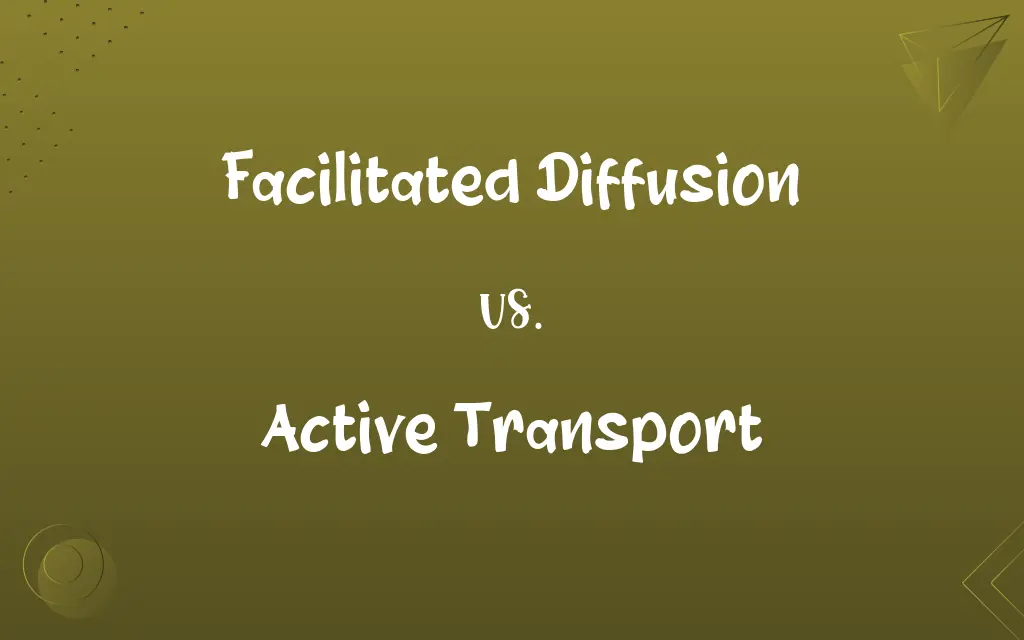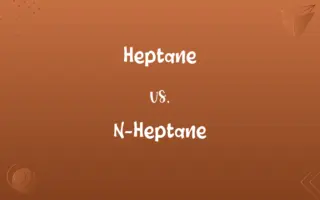Facilitated Diffusion vs. Active Transport: Know the Difference

By Shumaila Saeed || Published on January 9, 2024
Facilitated diffusion is passive transport across a membrane through protein channels, while active transport requires energy to move substances against a concentration gradient.

Key Differences
Facilitated diffusion does not require energy, allowing substances to move passively down their concentration gradient. Active transport, in contrast, requires energy (ATP) to move substances against their concentration gradient, from lower to higher concentration.
Shumaila Saeed
Jan 09, 2024
In facilitated diffusion, transport proteins in the cell membrane assist in the movement of substances. Active transport relies on specific protein pumps that use energy to transport molecules across the cell membrane.
Shumaila Saeed
Jan 09, 2024
Facilitated diffusion is often used for the movement of ions and small molecules. Active transport is crucial for transporting larger molecules or ions against their concentration gradient.
Shumaila Saeed
Jan 09, 2024
Facilitated diffusion helps maintain concentration gradients without energy expenditure. Active transport is essential for maintaining ion balances and transporting essential nutrients into cells.
Shumaila Saeed
Jan 09, 2024
An example of facilitated diffusion is the movement of glucose into cells. An example of active transport is the sodium-potassium pump in nerve cells.
Shumaila Saeed
Jan 09, 2024
ADVERTISEMENT
Comparison Chart
Direction of Movement
With the concentration gradient
Against the concentration gradient
Shumaila Saeed
Jan 09, 2024
Example in Biological System
Glucose transport into cells
Sodium-potassium pump in nerve cells
Shumaila Saeed
Jan 09, 2024
ADVERTISEMENT
Facilitated Diffusion and Active Transport Definitions
Facilitated Diffusion
Protein-Assisted Movement
Glucose transport into muscle cells occurs via facilitated diffusion.
Shumaila Saeed
Dec 17, 2023
Active Transport
Cellular Pump Mechanism
Active transport uses protein pumps to move calcium ions.
Shumaila Saeed
Dec 17, 2023
Facilitated Diffusion
Passive Transport Mechanism
Oxygen enters cells through facilitated diffusion.
Shumaila Saeed
Dec 17, 2023
Active Transport
Maintaining Ion Balance
Active transport is essential for maintaining ion gradients across membranes.
Shumaila Saeed
Dec 17, 2023
Facilitated Diffusion
Energy-Independent Process
Facilitated diffusion allows for efficient substance movement without using cellular energy.
Shumaila Saeed
Dec 17, 2023
ADVERTISEMENT
Active Transport
Transport of Large Molecules
Active transport mechanisms help in the uptake of glucose against its gradient.
Shumaila Saeed
Dec 17, 2023
Facilitated Diffusion
Cell Membrane Transport
Water-soluble molecules often require facilitated diffusion to cross the cell membrane.
Shumaila Saeed
Dec 17, 2023
Active Transport
Energy-Dependent Transport
Active transport is vital for accumulating nutrients inside the cell.
Shumaila Saeed
Dec 17, 2023
Facilitated Diffusion
Concentration Gradient-Dependent
In facilitated diffusion, ions move according to the concentration gradient.
Shumaila Saeed
Dec 17, 2023
Active Transport
Against Concentration Gradient
The sodium-potassium pump is an example of active transport.
Shumaila Saeed
Dec 17, 2023
Repeatedly Asked Queries
Can facilitated diffusion occur with any molecule?
No, it is specific to molecules that can be transported by membrane proteins.
Shumaila Saeed
Jan 09, 2024
Does facilitated diffusion require energy?
No, facilitated diffusion does not require cellular energy.
Shumaila Saeed
Jan 09, 2024
How does active transport work?
Active transport moves substances against their concentration gradient using energy and protein pumps.
Shumaila Saeed
Jan 09, 2024
What substances are typically moved by active transport?
Active transport typically moves larger molecules and ions against their gradient.
Shumaila Saeed
Jan 09, 2024
What is facilitated diffusion?
Facilitated diffusion is a passive transport process where substances move down their concentration gradient through membrane proteins.
Shumaila Saeed
Jan 09, 2024
Is facilitated diffusion faster than active transport?
Facilitated diffusion is generally faster but limited by the concentration gradient.
Shumaila Saeed
Jan 09, 2024
How do temperature and pH affect facilitated diffusion?
Temperature and pH can affect the function of transport proteins in facilitated diffusion.
Shumaila Saeed
Jan 09, 2024
Can facilitated diffusion occur in both directions?
Yes, it can occur in either direction, depending on the concentration gradient.
Shumaila Saeed
Jan 09, 2024
How is ATP used in active transport?
ATP provides the energy required to power protein pumps in active transport.
Shumaila Saeed
Jan 09, 2024
Can facilitated diffusion become saturated?
Yes, it can become saturated if the concentration of the transported substance is high.
Shumaila Saeed
Jan 09, 2024
How does active transport contribute to nerve function?
Active transport maintains ion gradients essential for nerve impulse transmission.
Shumaila Saeed
Jan 09, 2024
Why is active transport important for cells?
Active transport is crucial for maintaining ion balances and importing nutrients.
Shumaila Saeed
Jan 09, 2024
What factors influence the rate of facilitated diffusion?
The concentration gradient and availability of transport proteins influence its rate.
Shumaila Saeed
Jan 09, 2024
What role do protein channels play in facilitated diffusion?
Protein channels assist in the passive movement of substances across the membrane.
Shumaila Saeed
Jan 09, 2024
How do cells regulate facilitated diffusion?
Cells regulate it through the expression and activity of specific transport proteins.
Shumaila Saeed
Jan 09, 2024
Can facilitated diffusion and active transport occur simultaneously?
Yes, both processes can occur simultaneously in cells for different substances.
Shumaila Saeed
Jan 09, 2024
What is an example of active transport in humans?
The sodium-potassium pump in nerve cells is a key example.
Shumaila Saeed
Jan 09, 2024
Is active transport selective?
Yes, it is highly selective, depending on the specific protein pumps used.
Shumaila Saeed
Jan 09, 2024
Can active transport occur without oxygen?
In anaerobic conditions, active transport can be limited due to reduced ATP production.
Shumaila Saeed
Jan 09, 2024
Why is active transport necessary for plant roots?
Active transport allows plant roots to absorb nutrients from the soil against the gradient.
Shumaila Saeed
Jan 09, 2024
Share this page
Link for your blog / website
HTML
Link to share via messenger
About Author
Written by
Shumaila SaeedShumaila Saeed, an expert content creator with 6 years of experience, specializes in distilling complex topics into easily digestible comparisons, shining a light on the nuances that both inform and educate readers with clarity and accuracy.









































































